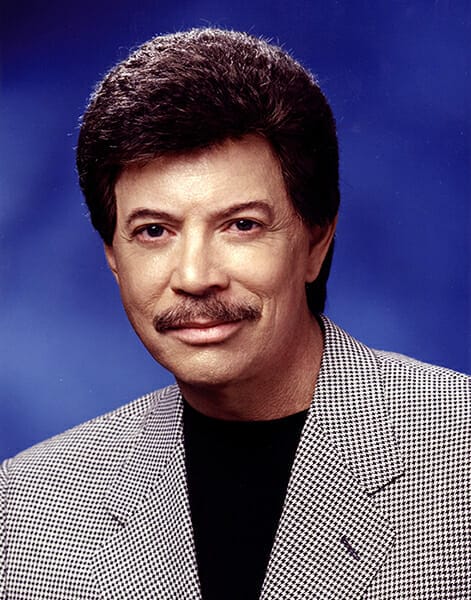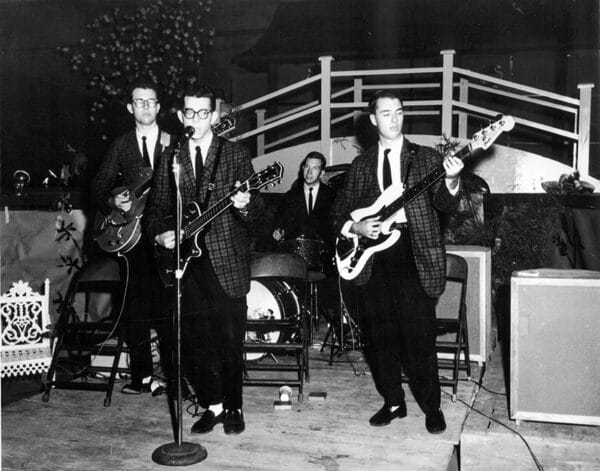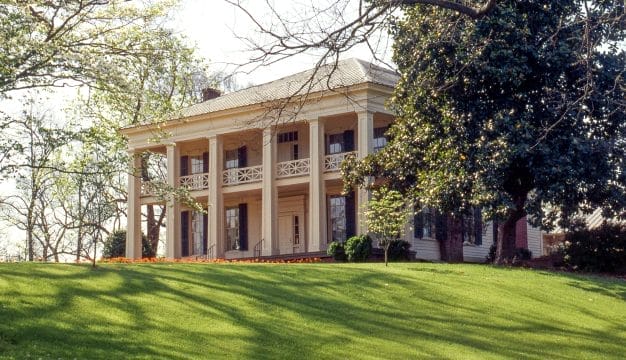Bobby Goldsboro
A 1999 inductee into the Alabama Music Hall of Fame, Bobby Goldsboro is a singer and composer (1941- ) who was a popular celebrity during the 1960s and 1970s. His recordings were listed 29 times on Billboard singles, country, and Canadian charts from 1964 to 1968. His greatest hit was “Honey” (1968), which exceeded one million sales in just three weeks and became the year’s biggest-selling record. Goldsboro also became a prolific composer, music publisher, producer of children’s entertainment, and talented painter. His song-writing has so far earned 27 Broadcast Music, Inc., awards, and he has sold an estimated 35 million records.
 Bobby Goldsboro
Goldsboro was born on January 18, 1941, in Marianna, Florida, the younger son of Charles Edward and Grace Wynell (Nell) Cawthon Goldsborough, who owned and operated a flower shop. Goldsboro had one older brother. After ninth grade the family moved to Dothan, Houston County, where Bobby (who later changed the spelling of his last name) became an avid baseball player with the ambition of playing for the Cleveland Indians. When his physical size limited his athletic potential, he found an outlet for his energy in music. At age 12, Goldsboro had taught himself how to play a borrowed ukulele and later became proficient at playing other instruments and at singing. While attending Dothan High School, he joined a band called The Webs, which played for local dances. Goldsboro entered Alabama Polytechnic Institute (soon to be renamed Auburn University) in 1959 as a business administration major, but continued to return to Dothan on weekends and vacations to play with The Webs. By his sophomore year, The Webs had relocated to Auburn, where they won a campus talent show with Goldsboro singing Neil Sedaka’s “Happy Birthday, Sweet Sixteen.” Their growing reputation soon led to bookings for fraternity house parties and other shows from Florida to Missouri, earning the group as much as $100 per musician for each performance. While on a spring break from Auburn University, Goldsboro met Mary Alice Watson, a sophomore at Dothan High School. After her graduation, they were married on November 11, 1962, and would have three children.
Bobby Goldsboro
Goldsboro was born on January 18, 1941, in Marianna, Florida, the younger son of Charles Edward and Grace Wynell (Nell) Cawthon Goldsborough, who owned and operated a flower shop. Goldsboro had one older brother. After ninth grade the family moved to Dothan, Houston County, where Bobby (who later changed the spelling of his last name) became an avid baseball player with the ambition of playing for the Cleveland Indians. When his physical size limited his athletic potential, he found an outlet for his energy in music. At age 12, Goldsboro had taught himself how to play a borrowed ukulele and later became proficient at playing other instruments and at singing. While attending Dothan High School, he joined a band called The Webs, which played for local dances. Goldsboro entered Alabama Polytechnic Institute (soon to be renamed Auburn University) in 1959 as a business administration major, but continued to return to Dothan on weekends and vacations to play with The Webs. By his sophomore year, The Webs had relocated to Auburn, where they won a campus talent show with Goldsboro singing Neil Sedaka’s “Happy Birthday, Sweet Sixteen.” Their growing reputation soon led to bookings for fraternity house parties and other shows from Florida to Missouri, earning the group as much as $100 per musician for each performance. While on a spring break from Auburn University, Goldsboro met Mary Alice Watson, a sophomore at Dothan High School. After her graduation, they were married on November 11, 1962, and would have three children.
 The Webs
In the summer of 1961, popular singer Roy Orbison, disenchanted with his own band, hired The Webs as his backup band for shows in Dothan and several cities in Florida, including Panama City, Pensacola, and Tallahassee. Orbison was so pleased that he persuaded Goldsboro to forego his last two years at Auburn University and join him, along with the rest of The Webs, on tour for the next three years. During a two-week bus tour of England, they headlined with the Beatles, responding to crowd pandemonium with three or four encores at every performance. Goldsboro amused the other musicians with his imitation of a tree frog, which Paul McCartney also became adept at doing. The “mop-top” image of the Beatles soon became part of Goldsboro’s professional look.
The Webs
In the summer of 1961, popular singer Roy Orbison, disenchanted with his own band, hired The Webs as his backup band for shows in Dothan and several cities in Florida, including Panama City, Pensacola, and Tallahassee. Orbison was so pleased that he persuaded Goldsboro to forego his last two years at Auburn University and join him, along with the rest of The Webs, on tour for the next three years. During a two-week bus tour of England, they headlined with the Beatles, responding to crowd pandemonium with three or four encores at every performance. Goldsboro amused the other musicians with his imitation of a tree frog, which Paul McCartney also became adept at doing. The “mop-top” image of the Beatles soon became part of Goldsboro’s professional look.
In 1964, Goldsboro left Orbison, with whom he had developed a close relationship, and The Webs as well. He refined his skills as a songwriter and produced the first two Top 40 hits of his solo career: “See the Funny Little Clown” (1964) and “Little Things” (1965). Later The Webs accompanied the Beatles on the final concert of their first United States tour, emceed by Ed Sullivan at the Paramount Theatre in New York; they also opened for five Rolling Stones engagements, one of which included Carnegie Hall. Stones guitarist Keith Richards credits Goldsboro with teaching him a new guitar chord.
Ironically, Goldsboro’s most famous recording, “Honey,” which reached the top of all the charts in 1968, was written by Bob Russell, not by Goldsboro. It relates the story of the tragic death of a young bride. His other hits include “Voodoo Woman,” “It’s Too Late,” “Blue Autumn,” “Muddy Mississippi Line,” “The Straight Life,” “Watching Scotty Grow,” and “With Pen in Hand.” Between 1960 and 1974, Goldsboro released 44 singles and 20 albums. His compositions have been performed by such artists as Aretha Franklin, John Denver, Paul Anka, Dolly Parton, Johnny Cash, Conway Twitty, and Bette Midler.
As a result of his popular songs and quick wit, Goldsboro became a familiar guest on such television talk shows as The Tonight Show and The Mike Douglas Show,, leading to The Bobby Goldsboro Show, which became a highly rated syndicated variety show between 1973 and 1975. Second only to Goldsboro’s singing on the show was the popularity of a regular comedy skit centered around a lively, irreverent tree frog named Calvin. This character spawned a board game called “Rrib-Bit.” Goldsboro also formed House of Gold Music in 1971, which published such hits as “Wind Beneath My Wings” and “Behind Closed Doors” and became one of the most successful music publishing houses in Nashville.
Goldsboro divorced Mary Alice Watson Goldsboro in 1982 in a bitter divorce that almost ruined Goldsboro’s image as a clean-cut all-American boy. He married Dianne J. Goldsboro on April 11, 1985. Afterward he devoted more of his time to writing and producing children’s stories. His Easter Egg Mornin’, an animated Easter special, premiered on the Disney Channel in 1991; Goldsboro wrote the music and contributed the voice of its star, Picasso “Speedy” Cottontail. He also composed and performed a new theme song in 1993 for Evening Shade, a CBS comedy starring Burt Reynolds, and produced new music for the show each week. In 1996, Goldsboro launched a 52-episode series, The Swamp Critters of Lost Lagoon, on PBS, The Learning Channel, America One Network, Dish Network, and Sky Angel. Goldsboro wrote all the scripts, played all the instruments, and performed all the animal voices for the series.
In the twenty-first century, Goldsboro began developing his interest in painting; he has exhibited his works at one-man art shows at galleries around the country and regularly donates his paintings to charities for fund-raisers. His paintings also have been widely purchased by art collectors and featured at such venues as the Sweet Gallery in Naples, Florida; the Stellers Gallery in Jacksonville, Florida; the Gateway Bank of Central Florida; and the May Gallery in Scottsdale, Arizona. He focuses mostly on naturalistic themes, including landscapes, birds, and flowers.
Although he achieved fame as a major international singing star with 16 top 40 hits on the Billboard Hot 100, he never forgot his Alabama roots. He recalls that he matured as a student at Auburn University and remains an avid Auburn fan.
Additional Resources
Bickhart, Jim. “Watching Bobby Grow, A Decade of Hits.” Billboard, October 5, 1974.
Davis, Owen. “Goldsboro, Hart Have Singing Roots Here.” The Auburn Bulletin, May 3, 1973.
“Goldsboro Vows to Fight Forever to Clear Name.” The Citizen (Ottawa), October 24, 1983.
Kazek, Kelly, Hidden History of Auburn. Charleston, S.C.: History Press, 2011.
“Show Adds Goldsboro.” Montgomery Advertiser, April 11, 1976
Wallace, Gloria. “Goldsboro Glad Music His Career.” Montgomery Advertiser, April 30, 1973


